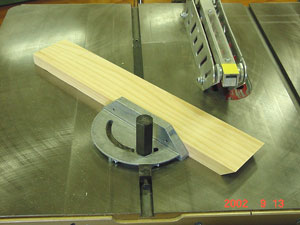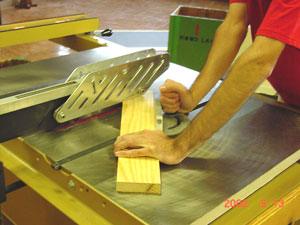Miter Cut on the Circular Saw
|
|
The circular saw is one of the most versatile machines used for woodworking. It can be used for a wide variety of operations including: ripping, crosscutting; as well as other operations such as cutting miters, rabbets, dados, and coves. This sheet describes the procedure for cutting miters. |
Controls: The controls on the circular saw in the materials processing laboratory consist of the following:
- A magnetic power switch that must be reset if the power in the laboratory is interrupted.
- A blade height adjustment wheel on the front of the machine.
- A blade tilt adjustment wheel on the side of the machine.
- Fence adjusting knob and fence lock on the rip fence.
Note: There are other controls on various accessories
used with the saw that are not listed in this
discussion.
Potential hazards: Because of the rapid spinning motion of the circular saw blade, the following hazards exist.
- Any body contact with the moving blade will cause severe injury.
- Clothing or other articles that contact the moving blade could become entangled and pull the operator into the blade.
- The work piece can be thrown (kicked back) violently from the rotating saw blade.
- Small pieces of the work piece and saw dust can be thrown out at the operator.
- The operator could slip and fall into the saw.
Safety practices: Because of those potential hazards the following safety rules must be followed.
- Be sure to perform only operations you know how to do safely.
- Always wear safety glasses.
- Never wear cloths or other articles that dangle and could catch on the saw.
- Be sure to have firm footing.
- Check the saw to make sure it is in good working order.
- Make all adjustments with the saw turned off, and unplugged in cases where the blade is or could be touched.
- Use an appropriate saw blade guard when possible. (most operations can be done with the guard), check with the instructor before making any cuts without the guard.
- Adjust the blade to 1/8 inch above the top of the stock.
- Check the stock for foreign objects and never saw stock containing loose or unsound knots.
- Never make "free hand" cuts on the circular saw, always use the fence, miter gage or other fixture.
- Never stand directly behind the saw blade.
- When using the miter gage be sure it slides freely and clears the blade.
- Do not reach directly over the moving blade to remove stock.
- Use a push stick for narrow work when ripping.
- Turn the saw off before clearing any materials from near the blade.
- Always use a clearance block when cross cutting duplicate parts (do not use the fence and miter gage in direct combination), the stock can bind and kick back .
- Have someone help support long stock, but don't allow them to pull the stock.
- Avoid distractions, never look away during a cut.
- Do not allow others to crowd around the saw.
- Turn the saw off immediately if it does not sound right or if slivers of wood catch between the blade and table.
- Always push the work well beyond the blade when finishing a cut (clearing the saw).
- Never let go of the stock during the cut.
- Do not saw stock that rocks on the table or that does not track straight along the fence.
- Lower the blade below the table surface after after finishing the operation.
Operation (Miter): A
miter is a crosscut made at an angle. Refer to the following
illustrations.
- Be sure that the stock to be cut is flat and has a
straight edge.
- Check to be sure that a rip or combination blade is
mounted on the saw.
- Adjust the saw blade to approximately 1/8 to 1/4 inch higher than the thickness of the stock.
- Adjust the miter gage to the desired degree by loosening the handle at the base, turning the gage to the desired degree and tightening the handle.
- The miter gage can be either open or closed faced toward the saw blade. An open miter gage is facing away from the saw blade. A closed miter gage is facing toward the saw blade. An open and closed miter gage can be achieved on both sides of the saw blade.
- Never use the rip fence with this operation.
- Be sure the blade guard is in place and functioning properly.
- Stand to the side of the blade and start the saw. Be sure no other people are in line with the blade.
- Using the miter gage on the left or right side of the blade, push the stock through.
- Be sure to push the stock well clear of the blade when finishing the cut (clearing the saw).
- Turn off the saw before removing the stock
Note: There are several other operations that can be done using a circular saw. Ask your instructor and refer to one of the many references for those procedures.
|
|
|
|
Setting the miter gage at an angle in preperation for cutting. |
Stock is being pushed into the blade at an angle, note the position of the hands. |
References:
Hammond, James J., Donnelly, Edward T., Harrod, Walter F., Rayner, Norman A. (1972). Woodworking Technology. McKnight and McKnight Publishing Co. Bloomington, IL.
Feirer, John L. (1988). Cabinetmaking and Millwork. Glencoe/McGraw-Hill. Peoria, IL.
ITT 252 - Materials Processing
Department of Technology
University of Southern Maine
Prepared by Kevin M. Hanscom, 9/6/2001

